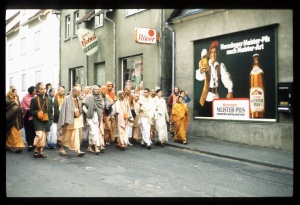CC Madhya 25.93: Difference between revisions
m (1 revision(s)) |
No edit summary |
||
| Line 1: | Line 1: | ||
{{ | [[Category:Sri Caitanya-caritamrta - Madhya-lila Chapter 25|C093]] | ||
<div style="float:left">'''[[Sri Caitanya-caritamrta|Śrī Caitanya-caritāmṛta]] - [[CC Madhya|Madhya-līlā]] - [[CC Madhya 25|Chapter 25: How All the Residents of Vārāṇasī Became Vaiṣṇavas]]'''</div> | |||
<div style="float:right">[[File:Go-previous.png|link=CC Madhya 25.92|Madhya-līlā 25.92]] '''[[CC Madhya 25.92|Madhya-līlā 25.92]] - [[CC Madhya 25.94|Madhya-līlā 25.94]]''' [[File:Go-next.png|link=CC Madhya 25.94|Madhya-līlā 25.94]]</div> | |||
{{CompareVersions|CC|Madhya 25.93|CC 1975|CC 1996}} | |||
{{RandomImage}} | |||
==== TEXT 93 ==== | ==== TEXT 93 ==== | ||
<div class="verse"> | |||
<div | :yei sūtra-kartā, se yadi karaye vyākhyāna | ||
yei sūtra-kartā, se yadi karaye vyākhyāna | :tabe sūtrera mūla artha lokera haya jñāna | ||
tabe sūtrera mūla artha lokera haya jñāna | |||
</div> | </div> | ||
| Line 13: | Line 16: | ||
==== SYNONYMS ==== | ==== SYNONYMS ==== | ||
<div class="synonyms"> | |||
<div | '' yei sūtra-kartā''—the person who has made the ''Vedānta-sūtra''; ''se''—that person; ''yadi''—if; ''karaye vyākhyāna''—explains the meaning; ''tabe''—then; ''sūtrera''—of the aphorisms of the ''Vedānta-sūtra''; ''mūla''—the original; ''artha''—meaning; ''lokera''—of the people in general; ''haya jñāna''—comes within knowledge. | ||
yei sūtra- | |||
</div> | </div> | ||
| Line 21: | Line 23: | ||
==== TRANSLATION ==== | ==== TRANSLATION ==== | ||
<div class="translation"> | |||
"If the Vedānta-sūtra is explained by Vyāsadeva himself, who has written it, its original meaning can be understood by the people in general. | |||
</div> | |||
<div | |||
<div style="float:right; clear:both;">[[File:Go-previous.png|link=CC Madhya 25.92|Madhya-līlā 25.92]] '''[[CC Madhya 25.92|Madhya-līlā 25.92]] - [[CC Madhya 25.94|Madhya-līlā 25.94]]''' [[File:Go-next.png|link=CC Madhya 25.94|Madhya-līlā 25.94]]</div> | |||
</div> | __NOTOC__ | ||
__NOTOC__ | __NOEDITSECTION__ | ||
Revision as of 06:12, 17 September 2021
Śrī Caitanya-caritāmṛta - Madhya-līlā - Chapter 25: How All the Residents of Vārāṇasī Became Vaiṣṇavas

His Divine Grace
A.C. Bhaktivedanta Swami Prabhupada
A.C. Bhaktivedanta Swami Prabhupada
TEXT 93
- yei sūtra-kartā, se yadi karaye vyākhyāna
- tabe sūtrera mūla artha lokera haya jñāna
SYNONYMS
yei sūtra-kartā—the person who has made the Vedānta-sūtra; se—that person; yadi—if; karaye vyākhyāna—explains the meaning; tabe—then; sūtrera—of the aphorisms of the Vedānta-sūtra; mūla—the original; artha—meaning; lokera—of the people in general; haya jñāna—comes within knowledge.
TRANSLATION
"If the Vedānta-sūtra is explained by Vyāsadeva himself, who has written it, its original meaning can be understood by the people in general.